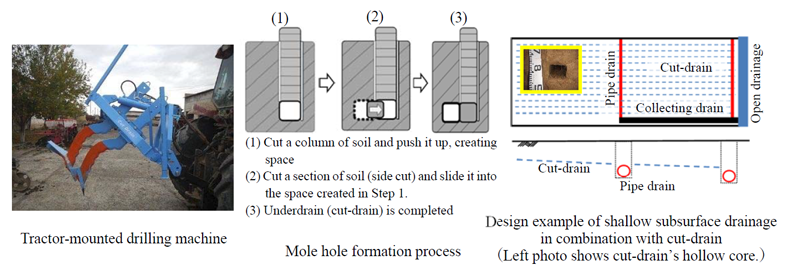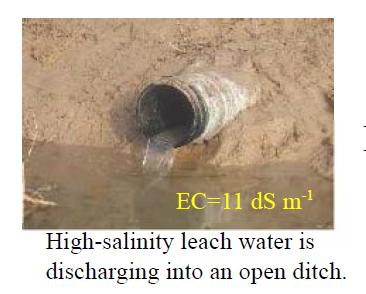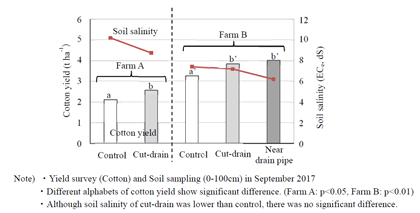Technical manual on building a low-cost, shallow subsurface drainage system for mitigating salinization
Description
Agricultural productivity in the arid and semi-arid zones of Central Asia increased dramatically during the 1950s owing to large-scale development of irrigated land using the water resources of Amu-darya and Syr-darya Rivers. Simultaneously, however, inadequate water management and poor drainage have led to widespread salinization, especially over a large area in Uzbekistan causing serious damage to agricultural production. Several measures, such as constructing a drainage system, dredging of drainage ditches, and leaching operations to remove salt from farm fields, have been taken to mitigate salinization. Still,salinity levels have remained high in many farm fields as incomplete dredging operations, decreased discharge of deep subsurface drainage, and ineffective vertical drainage systems only had a minimal leaching effect. Thus, we proposed a shallow subsurface drainage technology to ensure effective salt removal (by leaching) from the surface soil layer. The technology was investigated in combination with a new drain drilling machine developed in Japan. The machine can construct relatively stable, low-cost mole holes (hereinafter referred to as “cut-drain”) to depths between 60 to 90 cm from the surface. The cut-drain was initially applied in semi-arid areas for reducing salt loads from shallow subsurface drainage. The information gathered about the technology was later described and compiled into a technical manual after field experiments.
The manual is composed of the following sections, namely, “The mechanism of salt accumulation and countermeasures,” “The factors of salinization in the experimental site,” and “Shallow subsurface drainage technology.” The contents are described in a simple manner and conveyed intelligibly using photos or illustrations (Fig. 1). The shallow subsurface drainage is explained in the manual according to the planning and construction method, the appropriate soil conditions (i.e., suitable soil texture and soil moisture), and problems (e.g., collapse of cut-drain) and its countermeasures. In the farm field where the shallow subsurface drainage technology was applied, high salinity water was discharged from the field to the open drainage (Fig. 2), decreasing soil salinity and subsequently resulting to an approximately 20% increase in cotton yield (Fig. 3).
The manual is expected to be applied in arid or semi-arid zones. Cut-drains should be constructed in areas where the soils meet certain texture and moisture conditions (i.e., the texture should have a low proportion of sand or silt, and it should not be too hard and dry). The manual was translated into Japanese, English, and Russian in agreement with the Farmers’ Council (FC) and concerned research institutes in Uzbekistan. In addition, an abridged version was also translated into English, Russian, and Uzbek for field use. The drilling machine is relatively expensive for farmers. Therefore, FC has an important role to play in supporting farmers, such as providing easy access to use the machine.
Figure, table
-
Fig. 1. Examples of photos and illustrations in the technical manual
-
Fig. 2. Outlet of collecting drain
-
Fig. 3. Crop yield and soil salinity in the field with shallow subsurface drainage
- Affiliation
-
Japan International Research Center for Agricultural Sciences Rural Development Division
- Program name
- Term of research
-
FY2017(2013~2017)
- Responsible researcher
-
Okusa Yukio ( Rural Development Division )
MIERUKA ID: 001735Omori Keisuke ( Rural Development Division )
MIERUKA ID: 001793Onishi Junya ( Rural Development Division )
- ほか
- Publication, etc.
-
Shallow sub‐surface drainage for mitigating salinization Technical Manual
https://www.jircas.go.jp/en/publication/manual_guideline/mitigating_sal…Shallow sub‐surface drainage for mitigating salinization Technical Manual
https://doi.org/10.11408/jsidre.85.II_83Okuda et al.(2017)Transactions of The Japanese Society of Irrigation, Drainage and Rural Engineering, 305(85-2):83-90
Omori et al. (2018) Sand dune research Vol.64-3:101-112
https://doi.org/10.14976/jals.27.3_91Onishi et al. (2017) Journal of arid land studies, 27(3):91-101
Okuda et al. (2015) Journal of the Japanese Society of Irrigation, Drainage and Rural Engineering, 83(5):21-24
Okuda et al. (2015) Journal of the Japanese Society of Irrigation, Drainage and Rural Engineering, 83(7):7-10
- Japanese PDF
-
A4 406.91 KB
A3 364.54 KB
- English PDF
-
A4 263.71 KB
A3 236.14 KB
- Poster PDF
-
2017_A03_poster.pdf443.86 KB



